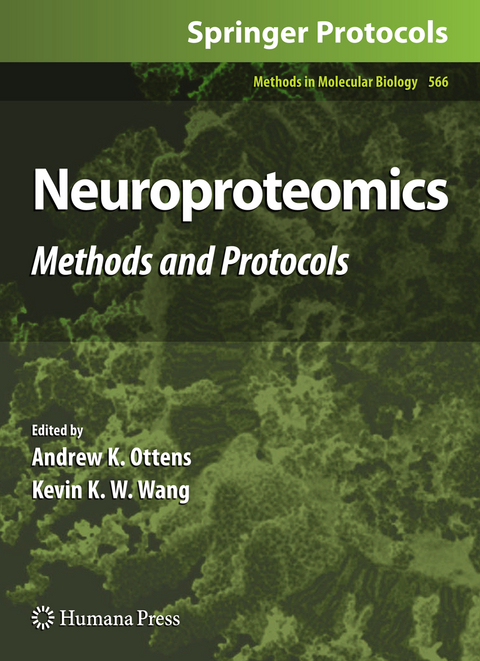
Neuroproteomics
Humana Press Inc. (Verlag)
978-1-61779-754-5 (ISBN)
Disease Models in Neuroproteomics.- The Methodology of Neuroproteomics.- Modeling Cerebral Ischemia in Neuroproteomics.- Clinical and Model Research of Neurotrauma.- Neuroproteomic Methods in Spinal Cord Injury.- Modeling Substance Abuse for Applications in Proteomics.- Protein Aggregate Characterization in Models of Neurodegenerative Disease.- Sub-Proteome Separations and Neuroproteomic Analysis.- Sub-Proteome Processing: Isolation of Neuromelanin Granules from the Human Bra.- Proteomic Analysis of Protein Phosphorylation and Ubiquitination in Alzheimer’s Disease.- Proteomics Identification of Carbonylated and HNE-Bound Brain Proteins in Alzheimer’s Disease.- Mass Spectrometric Identification of In Vivo Nitrotyrosine Sites in the Human Pituitary Tumor Proteome.- Improved Enrichment and Proteomic Analysis of Brain Proteins with Signaling Function by Heparin Chromatography.- Calmodulin-Binding Proteome in the Bra.- Neuroproteomic Methodology and Bioinformatics.- Separation of the Neuroproteome by Ion Exchange Chromatography.- iTRAQ-Based Shotgun Neuroproteomics.- Methods in Drug Abuse Neuroproteomics: Methamphetamine Psychoproteome.- Shotgun Protein Identification and Quantification by Mass Spectrometry in Neuroproteomics.- Biofluid Analysis and Clinical Translation.- Identification of Glycoproteins in Human Cerebrospinal Fluid.- Mass Spectrometric Analysis of Body Fluids for Biomarker Discovery.- Traumatic Brain Injury Biomarkers: From Pipeline to Diagnostic Assay Development.- Translation of Neurological Biomarkers to Clinically Relevant Platforms.
From the reviews:
“This book provides experimental details about animal models for neuroproteomic research, methods for separating and analyzing discrete subcomponents of the neuroproteome, and CNS proteome characterization and quantification, as well as methods that evaluate biofluids and translate neuroproteomic results into clinical platforms. … The authors intend the book for basic and clinical researchers, and it will be of much interest to basic scientists, clinical scientists, and students interested in applying proteomics to the neurosciences.” (Omer Iqbal, Doody’s Review Service, March, 2010)
| Reihe/Serie | Methods in Molecular Biology ; 566 |
|---|---|
| Zusatzinfo | 51 Illustrations, black and white; XI, 321 p. 51 illus. |
| Verlagsort | Totowa, NJ |
| Sprache | englisch |
| Maße | 193 x 260 mm |
| Themenwelt | Medizin / Pharmazie ► Medizinische Fachgebiete ► Neurologie |
| Studium ► 1. Studienabschnitt (Vorklinik) ► Physiologie | |
| Naturwissenschaften ► Biologie ► Humanbiologie | |
| Naturwissenschaften ► Biologie ► Zellbiologie | |
| Naturwissenschaften ► Biologie ► Zoologie | |
| Schlagworte | Biofluid analysis • Bioinformatics • Biomarker research • Central nervous system - CNS • Clinical translation • Disease models • Mass Spectrometry • Proteom • Sub-proteome separations |
| ISBN-10 | 1-61779-754-5 / 1617797545 |
| ISBN-13 | 978-1-61779-754-5 / 9781617797545 |
| Zustand | Neuware |
| Haben Sie eine Frage zum Produkt? |
aus dem Bereich


